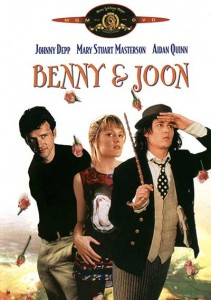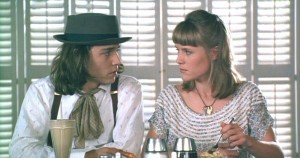
With Benny & Joon director Jeremiah S. Chechik delivers a timeless tale about ‘eccentric’ characters trying to find their niche and connect with those around them in a meaningful way.
The movie features Adian Quinn as Benjamin ‘Benny’ Pearl and Mary Stuart Masterson as his sister Juniper ‘Joon’ Pearl. The adult siblings are struggling to lead a normal life more than a decade after their parents died in a car crash. Artistic Joon leads a lonely life, mostly housebound and suffering from some unnamed mental illness. After their latest house keeper and aide for Joon quits, Benny is left with the difficult task of finding a replacement or considering the possibility of putting her in an institution.
In a sit-com worthy twist Benny ‘wins’ Sam (Johnny Depp) in a poker game with his buddies Mike (Joe Grifasi) and Thomas (Dan Hedaya) in which the stakes range from manual labour to odd items like snorkelling equipment and 100 ft of coaxial cable. Honouring his word, Benny takes the eccentric Sam home with them after the poker game.

Sam is no less ‘eccentric’ than Joon, dressing in period clothing and affecting the mannerisms of silent movie stars Buster Keaton and Charlie Chaplin. Sam also comes across as having some sort of learning disability that is hinted at during several scenes through out the movie. From the moment Sam arrives on the scene, the audience knows there is no question that Joon and Sam are meant to be together. Through their ‘handicaps’ and eccentricities the two seem to get each other, making each other comfortable, yet challenging each other to test their boundaries in ways they wouldn’t normally on their own.
While the Sam and Joon get to know each other better, Benny is forced to weigh the question whether he can let go of his sister and stop being her full-time protector and care-giver. Neither of his choices, setting her free in the world or putting her in a group home, hold very much appeal to him, but he realizes he needs to get on with his life as he watches potential relationships with the local waitress / actress Ruthie (Julianne Moore) slip through his fingers.
After the situation comes to a head, Joon makes the decision for him choosing to be admitted to a psychiatric ward at the hospital and refusing outside contact. In the climatic scene Benny and Sam are forced to team up to break into the hospital to see Joon and get her to change her mind.

While I found the film charming and boasting touching performances from all the actors involved, I still found it frustrating on some deeper level. One of the reasons I put ‘eccentric’ in quotes through out this review was that I felt the film makers were purposely blurring the lines between mental illness and eccentricity for their own gain and to avoid directly confronting the issue of mental illness head on. I know this is a film meant to entertain first and foremost and that if the directors and writers want to put whatever spin they want on a story they are free to do so and as an audience we are free to buy into the ‘myth’ they are creating on the big screen or not. But on the other hand, I can’t simply put my brain in park and ignore the mixed messages I am getting on the big screen either.
One of the mixed messages I got watching Benny & Joon is that love conquers all and that perhaps Joon is not mentally ill, but rather just ‘broken’ and can be fixed by love. I felt that by muddying the waters sufficiently through out the the film about whether Joon was schizophrenic or suffering from some sort of post-traumatic stress from the horrific death of her parents or something else, the film makers could conveniently play it in which ever way it suited the story. The other message that bothered me on some level was equating the eccentric nature of Joon and Sam’s characters with some sort of disability whether mental or otherwise. It was like hey, look there is something not right about these people, but hey they’re quirky and fun, so its okay. My problem with the message is that I want to accept eccentric people for who they are not assume their being ‘weird’ or different because of some underlying mental health issue or learning disability. Conversely I don’t expect everyone who is suffering from real mental health issues to be quirky and entertaining.
Ranting aside, I rather enjoyed the film, despite its flaws, and would rank it up there as another classic Depp film in which he disappears in the character of Sam and uses his talents as an actor to convey so much emotion with so little dialogue. Again as we will see through out Depp’s acting career his hair and wardrobe become key influences on his character. In Benny & Joon, Sam’s ‘long’ hair reinforce his image as someone who doesn’t fit the social norms and is more feminine than say Benny or his poker playing buddies. Likewise Buster Keaton’s trademark pork pie hat and Charlie Chaplin’s iconic bamboo cane become part of Sam’s character defining who he is. Depp who admired Keaton’s work before this film (and you can see Keaton’s influences in Depp’s character Edward Scissorhands) spent a lot of time watching old silent films of Keaton in preparation for this role.
Up next in my steady diet of Depp films is the second Depp film realeased in 1993, What’s Eating Gilbert Grape?, directed by Lasse Hallstrom and featuring Depp and newcomer Leonardo DiCaprio. Before I leave you though, I wanted to share this youtube video talking about Buster Keaton and his trademark hat.
Comment